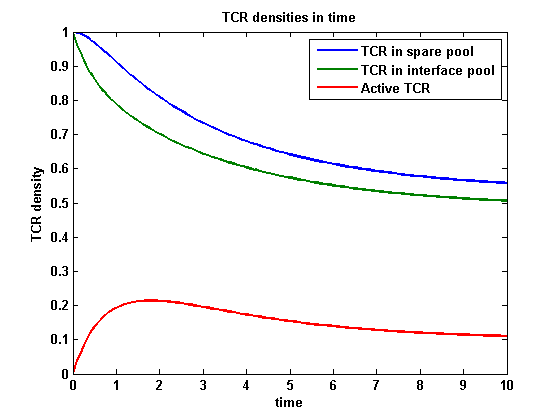Team:Freiburg/Modeling/Parameter analysis
From 2008.igem.org
(Difference between revisions)
m |
m |
||
| (6 intermediate revisions not shown) | |||
| Line 36: | Line 36: | ||
<br><br> | <br><br> | ||
<h4>Different parameter set </h4> | <h4>Different parameter set </h4> | ||
| - | The turnover rate ('''S''') is set to a value 10 times smaller than the previous value and the amount of the NIP is now 4 times smaller than in the calculation above. The TCR-NIP dissociating rate ('''k'''<sub>off</sub>) is 5 times smaller than the binding rate ('''k'''<sub>on</sub>). The same holds for the dimer | + | The turnover rate ('''S''') is set to a value 10 times smaller than the previous value and the amount of the NIP is now 4 times smaller than in the calculation above. The TCR-NIP dissociating rate ('''k'''<sub>off</sub>) is 5 times smaller than the binding rate ('''k'''<sub>on</sub>). The same holds for the dimer dissociating rate ('''k'''<sub>doff</sub>) in relation to the dimerization rate ('''k'''<sub>don</sub>). |
<table> | <table> | ||
<tr> | <tr> | ||
| Line 163: | Line 163: | ||
<h4>TCR activity dependent on exchange between spare and interface pool </h4> | <h4>TCR activity dependent on exchange between spare and interface pool </h4> | ||
| - | + | The TCR can switch from a non-binding state to a binding state or in other words, the TCRs in the spare pool can become TCRs in the interface pool. This exchange is regulated by the parameters '''λ''' and '''φ'''. '''λ''' is a ratio between the spare and the interface pool and '''φ''' is the exchange rate constant.<br><br> | |
| - | The TCR can switch from a non-binding state to a binding state or in other words, the TCRs in the spare pool can become TCRs in the interface pool. This exchange is regulated by the parameters '''λ''' and '''φ'''. '''λ''' is a ratio between the spare and the interface pool and '''φ''' is the exchange rate constant<br><br> | + | |
<table> | <table> | ||
<tr> | <tr> | ||
| Line 195: | Line 194: | ||
</tr> | </tr> | ||
</table> | </table> | ||
| - | For a very high ratio λ and a low exchange rate φ the ratio of the spare pool (non-binding TCR) to the interface pool (binding TCR) is high and the switching of a TCR between the non-binding and the binding state is low. Thus there is a low TCR activity because not enough TCRs are accessible by NIP. This can be | + | For a very high ratio λ and a low exchange rate φ the ratio of the spare pool (non-binding TCR) to the interface pool (binding TCR) is high and the switching of a TCR between the non-binding and the binding state is low. Thus there is a low TCR activity because not enough TCRs are accessible by NIP. This can be due to TCRs which are surrounded by big sized proteins who avoid a TCR-NIP formation. |
<table> | <table> | ||
<tr> | <tr> | ||
| Line 226: | Line 225: | ||
</tr> | </tr> | ||
</table> | </table> | ||
| - | A low ratio λ and a high exchange rate φ | + | A low ratio λ and a high exchange rate φ lead to a high TCR activity as enough TCRs are available in the interface pool for NIP binding. The fast changing from the non-binding to the binding state assures a sufficient amount of TCRs for TCR-NIP and then dimer formation.<br><br> |
TCR activity for different exchanges (parameters as in the plot above except: N=0.2) | TCR activity for different exchanges (parameters as in the plot above except: N=0.2) | ||
| Line 232: | Line 231: | ||
<tr> | <tr> | ||
<td> | <td> | ||
| - | [[image:Freiburg_08_TA_ERates.png|thumb|left|500px| | + | [[image:Freiburg_08_TA_ERates.png|thumb|left|500px|'''Figure 9''': Active TCR density in time for different exchanges]] |
</td> | </td> | ||
</tr> | </tr> | ||
</table> | </table> | ||
| - | The x-axis represents the time course of the activity, the y-axis represents both parameters | + | The x-axis represents the time course of the activity, the y-axis represents both parameters φ ( = y) and λ ( = 2 - y). So each black line in the plot is a time course of the TCR activity for a different φ and λ. The z-axis is the response intensity. With increasing exchange between the interface and spare pool, more TCRs switch to the binding state, hence more TCRs can bind NIP. As a consequence the active TCR density is higher then for a low exchange. <br> |
}} | }} | ||
Latest revision as of 22:49, 8 March 2009
 "
"










